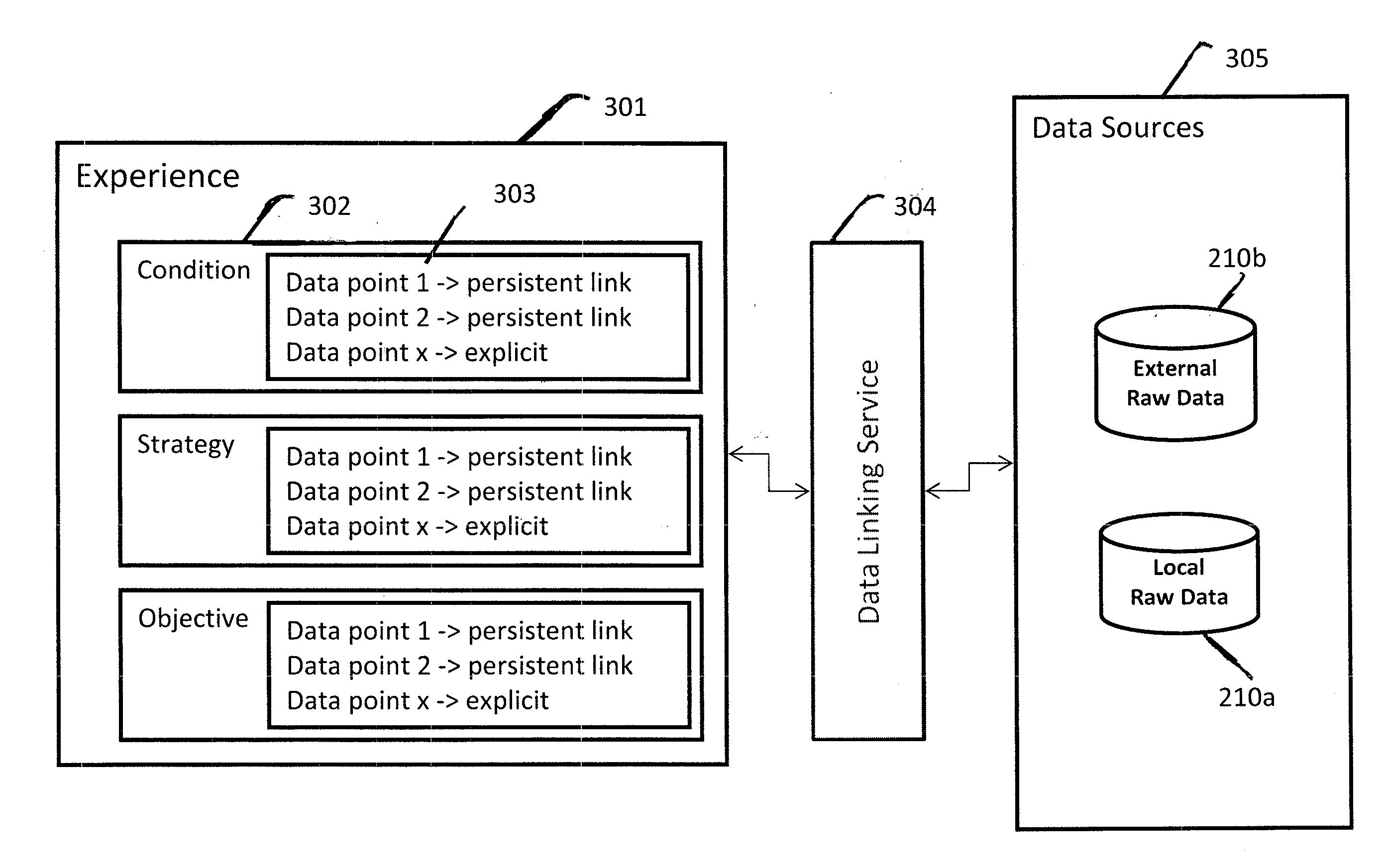[0009]In further considering these issues, the present inventor has further recognized that people commonly deal with three types of problems: those for which we do not know our objective, those for which we do not know our current condition, and those for which we do not know the strategy to get from our condition to the objective. Relatedly, the present inventor has recognized that, in general, a model of human experience (the ‘C—O—S Experience Model’) can be defined as comprising a Condition element (C, or initial state), an Objective element (O, or the state which is to be achieved), and a Strategy element (S, or the action or actions necessary to achieve a specific Objective from a specific Condition), where a specific completed Experience (E) is one in which an individual started at a specific Condition, and achieved a specific Objective, via a specific Strategy. Further, the present inventor has recognized that it is achievable to create systems and / or methods that can facilitate the obtaining of answers / solutions to questions / problems / needs by basing operation of such systems and / or methods upon an assumption that human experiences can reliably be modeled in this manner.
[0010]Thus, in at least some embodiments, the present disclosure relates to a system for modeling human experiences, allowing multiple individuals' experiences to be described in such a way so as to enable information about those experiences to be easily identified, assembled, and summarized for effective analysis and
decision making. Further, an individual looking to solve a specific problem can, using this system, more easily search for, find, aggregate and apply highly
relevant information by searching for information explicitly related to his or her immediate need. Also, in at least some embodiments, an individual's current experiential state can be described using an incomplete set of experience elements (for example, having started at a given Condition, and having chosen to employ a specific Strategy, but not yet having completed the intended Objective, or having specified an initial Condition, and a desired Objective, but not having chosen a specific Strategy to achieve the Objective).
[0011]Additionally, in at least some embodiments, the system captures a completed Experience upon achieving an Objective (O′), then updates the person's Condition from the original Condition (C′), to that new Condition (C″) which resulted from the movement from the original Condition (C′) to the original Objective (O′). The original Objective is now the new Condition. O′═C″. Further, at least some additional embodiments describe a complex experience using a set of sub-experiences. For example, a more complex project, such as building a house, can be decomposed into a set of interrelated sub-experiences that make the higher level project easier to model and manage. Further for example, sub-experience 1 may be to select a lot on which the house will be build, followed by step 2 which would be to obtain necessary permits, which depend on the
exact location of the lot, and therefore cannot be fully predicted before the lot is chosen. In such an alternative embodiment, a multi-phased experience can be modeled, yet allow future sub-experiences to be based on or made dependent on the exact, as yet unpredictable, outcome of an earlier sub experience.
[0013]Additionally in at least some embodiments, the system allows an individual who has specified their experiential state, or a hypothetical experiential problem to be solved, to manually initiate a search, or create computer agents to automatically initiate a search, to obtain experiential information from various sources, locally or distributed across public or private computer networks, such information being selected based on the extent to which the experiential information matches or aligns with one or more of the individual's specified experience elements. Also, in at least some embodiments, by using the C—O—S model to (i) capture a person's current experiential state or specify a hypothetical experiential problem to be solved, and (ii) structure or index information so as to be able to select only that specific information which aligns to the individual's experiential state, there is created a method which enables a computerized
information system to present information to the individual which is more relevant than data typically obtained using existing search mechanisms, because the information is directly applicable to the individual's specific situation and needs.
[0015]Further in at least some embodiments, as multiple experiences are completed by an individual, a
database of that person's completed C—O—S Experiences is built. Multiple persons' C—O—S Experiences can be consolidated into a single
database or linked over a
computer network. Experience databases can be made freely available and shared with select other individuals, or anyone, at no cost to others, or can be published and a fee charged to others for access to the
database. Sharing and comparing multiple persons' experiences creates a powerful tool to organically derive the optimal strategy for any situation, allowing a person to more easily identify the options available in a given situation based on the experiences of others who have been in the same condition, thereby providing context-specific information, enabling the person to make better decisions.
 Login to View More
Login to View More  Login to View More
Login to View More 


